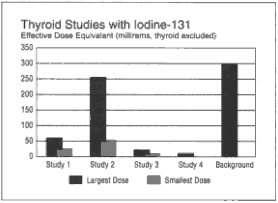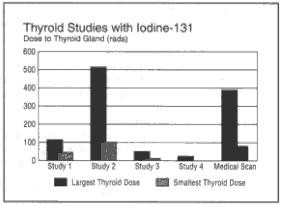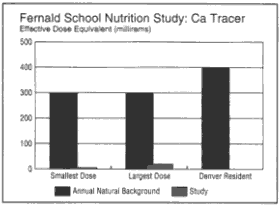The Manhattan Project: A New and Secret World of Human Experimentation
The Atomic Energy Commission and Postwar Biomedical Radiation Research
The Transformation in Government - Sponsored Research
New Ethical Questions for Medical Researchers
The Basics of Radiation Science
What Are Atomic Number and Atomic Weight?
Radioisotopes: What Are They and How Are They Made?
How Does Radiation Affect Humans?
How Do We Measure the Biological Effects of External Radiation?
How Do We Measure the Biological Effects of Internal Emitters?
How Do Scientists Determine the Long-Term Risks from Radiation?
How Do We Measure the Biological Effects of External Radiation?
The methods of measuring radiation and radioactivity, purely physical events, were discussed earlier. In studying the effect of radiation on living organisms, a biological event, the crucial data are the amount of energy absorbed by a specific amount and type of tissue. This requires first measuring the amount of energy left behind by the radiation in the tissue and, second, the amount and type of tissue.
What is an absorbed dose of radiation?
The risk posed to a human being by any radiation exposure depends partly upon the absorbed dose, the amount of energy absorbed per gram of tissue. Absorbed dose is expressed in rad. A rad is equal to 100 ergs of energy absorbed by 1 gram of tissue. The more modern, internationally adopted unit is the gray (named for the English medical physicist L. H. Gray); one gray equals 100 rad. Almost all the documents from the time period studied by the Advisory Committee use the term rad rather than gray. It is important to realize that absorbed dose refers to energy per gram of absorbing tissue, not total energy. Someone absorbing 1 gray (100 rad) in a small amount of tissue, such as a thyroid gland, will absorb much less total energy than someone absorbing 1 gray (100 rad) throughout his or her entire body. Thus, when speaking of absorbed dose, it is crucial to know the amount of tissue being exposed, not simply the number of gray or rad.
What is an equivalent dose of radiation?
Even the rad or gray, though, are still units that measure a purely physical event: the amount of energy left behind in a gram of tissue. It does not directly measure the biological effect of that radiation. The biological effect of the same amount of absorbed energy may vary according to the type of radiation involved. This biological effect can be computed by multiplying the absorbed dose (in rad or gray) by a number indicating the quality factor of the particular type of radiation. For photons and electrons the quality factor is defined to be 1; for neutrons it ranges from 5 to 20 depending on the energy of the neutron; for alpha particles it is 20.[104] Thus, 1 gray (100 rad) of alpha particles is currently judged to have an effect on living tissue that is twenty times more than 1 gray (100 rad) of x rays. Multiplying the absorbed dose (in rad or gray) by the quality factor (also known as the radiation weighting factor) produces what is called the equivalent dose. For the period studied by the Advisory Committee, this was expressed in terms of a unit called the rem, an acronym for roentgen equivalent man.106 (The term equivalent simply meant that an absorbed dose expressed in rem would have equivalent biological effects, regardless of the type of radiation. Thus, 10 rem of x rays should have the same biological effect as 10 rem of neutrons absorbed by the same part of the body.) The modern unit is the sievert (abbreviated Sv and named for the prominent Swedish radiologist, Rolf Sievert), which is equal to 100 rem. Thus, an equivalent dose of 200 rem would today be expressed as 2 sievert.
What is an effective dose of radiation?
Finally, the biological effect of radiation depends on the type of tissue being irradiated. As with different types of radiation, a weighting or quality factor is introduced depending on the type of tissue. The more sensitive the tissue is to radiation, the higher the factor. The effective dose is the sum of the equivalent doses of the various types of irradiated tissue, each properly weighted for its sensitivity to radiation. Tissue weighting factors are determined from the relative incidence of cancers in different tissues in the Japanese survivors of the atomic bombs.Calculating the effective dose makes it possible to readily compare different exposures, as illustrated by the accompanying graphs.
Experimental and Nonexperimental Doses *




